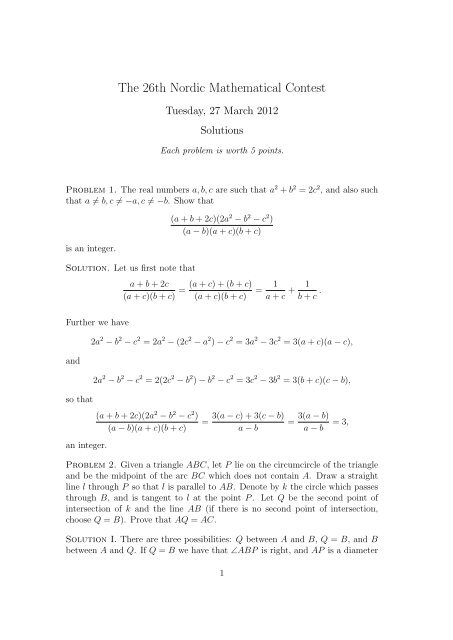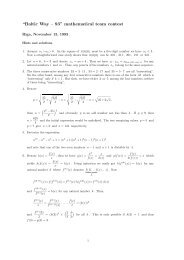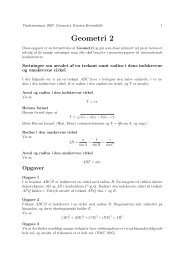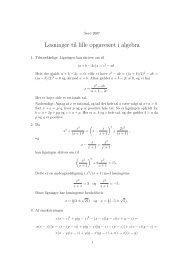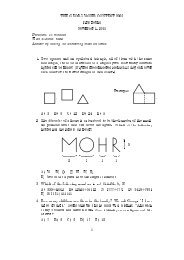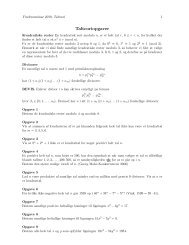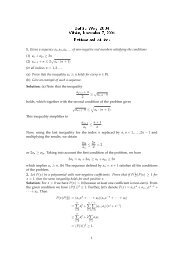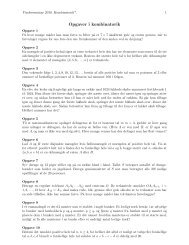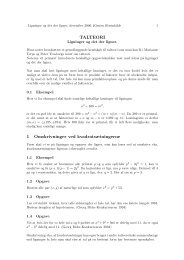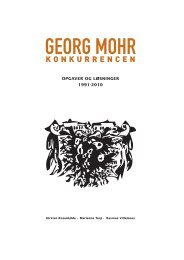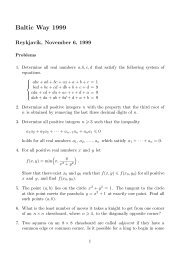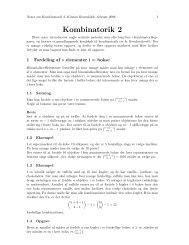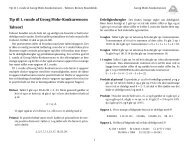The 26th Nordic Mathematical Contest - Georg Mohr-Konkurrencen
The 26th Nordic Mathematical Contest - Georg Mohr-Konkurrencen
The 26th Nordic Mathematical Contest - Georg Mohr-Konkurrencen
You also want an ePaper? Increase the reach of your titles
YUMPU automatically turns print PDFs into web optimized ePapers that Google loves.
<strong>The</strong> <strong>26th</strong> <strong>Nordic</strong> <strong>Mathematical</strong> <strong>Contest</strong><br />
Tuesday, 27 March 2012<br />
Solutions<br />
Each problem is worth 5 points.<br />
Problem 1. <strong>The</strong> real numbers a, b, c are such that a 2 + b 2 = 2c 2 , and also such<br />
that a ≠ b, c ≠ −a, c ≠ −b. Show that<br />
is an integer.<br />
(a + b + 2c)(2a 2 − b 2 − c 2 )<br />
(a − b)(a + c)(b + c)<br />
Solution. Let us first note that<br />
a + b + 2c<br />
(a + c)(b + c)<br />
=<br />
(a + c) + (b + c)<br />
(a + c)(b + c)<br />
= 1<br />
a + c + 1<br />
b + c .<br />
Further we have<br />
2a 2 − b 2 − c 2 = 2a 2 − (2c 2 − a 2 ) − c 2 = 3a 2 − 3c 2 = 3(a + c)(a − c),<br />
and<br />
2a 2 − b 2 − c 2 = 2(2c 2 − b 2 ) − b 2 − c 2 = 3c 2 − 3b 2 = 3(b + c)(c − b),<br />
so that<br />
(a + b + 2c)(2a 2 − b 2 − c 2 )<br />
(a − b)(a + c)(b + c)<br />
=<br />
3(a − c) + 3(c − b)<br />
a − b<br />
=<br />
3(a − b)<br />
a − b<br />
= 3,<br />
an integer.<br />
Problem 2. Given a triangle ABC, let P lie on the circumcircle of the triangle<br />
and be the midpoint of the arc BC which does not contain A. Draw a straight<br />
line l through P so that l is parallel to AB. Denote by k the circle which passes<br />
through B, and is tangent to l at the point P . Let Q be the second point of<br />
intersection of k and the line AB (if there is no second point of intersection,<br />
choose Q = B). Prove that AQ = AC.<br />
Solution I. <strong>The</strong>re are three possibilities: Q between A and B, Q = B, and B<br />
between A and Q. If Q = B we have that ∠ABP is right, and AP is a diameter<br />
1
of the circumcircle. <strong>The</strong> triangles ABP and ACP are then congruent (they have<br />
AP in common, P B = P C, and both have a right angle opposite to AP ). Hence<br />
ir follows that AB = AC.<br />
<strong>The</strong> solutions in the other two cases are very similar. We present the one in the<br />
case when Q lies between A and B.<br />
<strong>The</strong> segment AP is the angle bisector of the angle at A, since P is the midpoint<br />
of the arc BC of the circumcircle which does not contain A. Also, P C = P B.<br />
Since the segment QB is parallel to the tangent to k at P , it is orthogonal to<br />
the diameter of k through P . Thus this diameter cuts QB in halves, to form two<br />
congruent right triangles, and it follows that P Q = P B. We have (in the usual<br />
notation) ∠P CB = ∠P BC = α 2 , and<br />
∠AQP = 180 ◦ − ∠BQP = 180 ◦ − ∠QBP = 180 ◦ − β − α 2 = α 2 + γ = ∠ACP.<br />
Hence the triangles AQP and ACP are congruent (two pairs of equal angles and<br />
one pair of equal corresponding sides), and it follows that AC = AQ.<br />
Solution II. Again we consider the case when Q is between A and B. We shall<br />
use trigonometry. As above, we have ∠ABP = β + α , and thus<br />
2<br />
(<br />
QB = 2P B cos β + α )<br />
= 2P B cos<br />
(π − α )<br />
2<br />
2 − γ ,<br />
and<br />
AQ = 2R sin γ − 4R sin α 2 cos (<br />
π − α 2 − γ )<br />
.<br />
Since AC = 2R cos β, it remains to prove that<br />
sin β = sin γ + 2 sin α 2 cos ( α<br />
2 + γ )<br />
,<br />
which is easy, using standard trigonometry.<br />
Problem 3. Find the smallest positive integer n, such that there exist n integers<br />
x 1 , x 2 , . . . , x n (not necessarily different), with 1 ≤ x k ≤ n, 1 ≤ k ≤ n, and such<br />
that<br />
n(n + 1)<br />
x 1 + x 2 + · · · + x n = ,<br />
2<br />
and x 1 x 2 · · · x n = n!,<br />
but {x 1 , x 2 , . . . , x n } ≠ {1, 2, . . . , n}.<br />
Solution. If it is possible to find a set of numbers as required for some n = k,<br />
then it will also be possible for n = k + 1 (choose x 1 , . . . , x k as for n = k, and<br />
2
let x k+1 = k + 1). Thus we have to find a positive integer n such that a set as<br />
required exists, and prove that such a set does not exist for n − 1.<br />
For n = 9 we have 8 + 6 + 3 = 9 + 4 + 4, and 8 · 6 · 3 = 9 · 4 · 4, so that a set of<br />
numbers as required will exist for all n ≥ 9. It remains to eliminate n = 8.<br />
Assume x 1 , . . . , x 8 are numbers that satisfy the conditions of the problem. Since<br />
5 and 7 are primes, and since 2 · 5 > 8 and 2 · 7 > 8, two of the x-numbers<br />
have to be equal to 5 and 7; without loss of generality we can assume that<br />
x 1 = 5, x 2 = 7. For the remaining numbers we have x 3 x 4 · · · x 8 = 2 7 · 3 2 , and<br />
x 3 + x 4 + · · · + x 8 = 36 − 12 = 24. Since 3 2 = 9 > 8, it follows that exactly two of<br />
the numbers x 3 , . . . , x 8 are divisible by 3, and the rest of the numbers are powers<br />
of 2. <strong>The</strong>re are three possible cases to consider: two of the numbers are equal to<br />
3; two of the numbers are equal to 6; one number is equal to 3 and another one<br />
is equal to 6.<br />
Case 1. x 3 = x 4 = 3<br />
We then have x 5 + x 6 + x 7 + x 8 = 18, and x 5 x 6 x 7 x 8 = 2 7 . <strong>The</strong> possible powers of<br />
2 with sum 18 are (1, 1, 8, 8) and (2, 4, 4, 8), none of them gives the product 2 7 .<br />
Case 2. x 3 = 3, x 4 = 6<br />
We have x 5 +x 6 +x 7 +x 8 = 15, and x 5 x 6 x 7 x 8 = 2 6 . It is immediate to check that<br />
the only possibility for the remaining numbers is (1, 2, 4, 8), which is not allowed,<br />
since it gives {x 1 , x 2 , . . . , x 8 } = {1, 2, . . . , 8}.<br />
Case 3. x 3 = x 4 = 6<br />
Now we have x 5 + x 6 + x 7 + x 8 = 12, and x 5 x 6 x 7 x 8 = 2 5 . <strong>The</strong> possible powers<br />
of 2 which give the correct sum are (1, 1, 2, 8) and (2, 2, 4, 4), but again, they do<br />
not give the desired product.<br />
Thus the smallest positive integer with the required property is 9.<br />
Problem 4. <strong>The</strong> number 1 is written on the blackboard. After that a sequence<br />
of numbers is created as follows: at each step each number a on the blackboard<br />
is replaced by the numbers a − 1 and a + 1; if the number 0 occurs, it is erased<br />
immediately; if a number occurs more than once, all its occurrences are left on<br />
the blackboard. Thus the blackboard will show 1 after 0 steps; 2 after 1 step;<br />
1, 3 after 2 steps; 2, 2, 4 after 3 steps, and so on. How many numbers will there<br />
be on the blackboard after n steps?<br />
Solution I. Let S be a set of different numbers, all of them less than 2 n−1 ,<br />
and create two new sets as follows: S 1 , consisting of all the numbers in S except<br />
3
the smallest one, and S 2 , with elements the smallest element of S and all the<br />
numbers we get by adding 2 n−1 to each number in S. Note that if the number of<br />
elements in S is a, then S 1 has a − 1 elements, and S 2 has a + 1 elements. This<br />
corresponds to the operations we are allowed to perform on the blackboard, if we<br />
throw away all empty sets. If we now operate simultaneously on the sets and on<br />
the numbers, then after n steps the number of sets will be exactly equal to the<br />
number of numbers on the blackboard.<br />
Let us see what the set operations look like. We must start with a set, consisting<br />
only of the number 0. Next we get an empty set (thrown away), and<br />
the set {0, 1}; next the sets {1} and {0, 2, 3}; next again (an empty set and)<br />
{1, 5}, {2, 3}, {0, 4, 6, 7}, etc.<br />
It is now fairly easy to prove by induction that after n steps<br />
(1) each number less than 2 n appears in exactly one set;<br />
(2) the number of elements in the sets corresponds exactly to the numbers on the<br />
blackboard;<br />
(3) if the numbers in each set are written in increasing order, then the difference<br />
between two neighbours is a power of 2; thus the binary representations of<br />
two neighbours differ in exactly one position (in the binary system the example<br />
above looks like this: {0}; {0, 1}; {01}, {00, 10, 11}; {001, 101}, {010, 011},<br />
{000, 100, 110, 111});<br />
(4) if k is the number of ones in the binary code of the smallest number of a set,<br />
and l the number of ones in the largest number⌊ of the same set, then k + l = n;<br />
n<br />
⌋<br />
(5) each set contains exactly one number with ones.<br />
2<br />
<strong>The</strong> last property tells us that the number of sets after n steps is equal to⌊the<br />
n<br />
⌋<br />
number of numbers such that their binary representation contains exactly<br />
2<br />
ones out of n digits, ( i.e. ) the number of numbers on the blackboard after n steps<br />
n<br />
will be equal to<br />
⌊ n⌋ .<br />
2<br />
Solution II. Denote by σ n the number of numbers on the blackboard after n<br />
steps (thus σ 0 = σ 1 = 1, σ 2 = 2, σ 3 = 3, . . .). Regard all points in the plane with<br />
coordinates (m, n), where m, n are defined as follows: the number n is written<br />
on the blackboard after m steps (m, n are positive integers by the condition). At<br />
each node, i.e. each point with integer coordinates of the above type, write the<br />
number of occurrences of n after m steps. Thus the number written at (3, 2) will<br />
be the number of occurrences of 2 directly after step 3, which is 2. Observe that<br />
the number at each node is equal to the number of ways to reach this node from<br />
the point (0, 1), walking from one node to another one step at the time, from<br />
left to right and either up or down, without going down to the horizontal axis.<br />
4
(Since all zeroes are erased, we can never reach the horizontal axis.) For each m<br />
we want to find the total number of paths σ m , reaching the vertical line y = m.<br />
If we were to remove the constraint that we are not allowed to step on the<br />
horizontal axis (i.e. that all zeroes are erased), we would get Pascal’s triangle,<br />
and the total number of paths would be 2 m . <strong>The</strong> binomial coefficient at each<br />
node is then the total number of paths to reach this node, without constraint.<br />
We need to find and subtract the number of paths from A(0, 1) to a point B<br />
among the allowed nodes, which go down to the horizontal axis. Choose such a<br />
path, and find a new one by reflecting in the horizontal axis the part between the<br />
starting point (0, 1) and the path’s first contact with the horizontal axis. <strong>The</strong><br />
original path and the reflected one will end at the same point (among the allowed<br />
nodes); the reflected one will start at A ′ (0, −1). We have constructed a bijection<br />
between the original set of paths from A to B that reach down to the horizontal<br />
axis and the set of paths from A ′ to B. Observe that starting at A ′ we can get<br />
another copy of Pascal’s triangle, which is the original one, translated two units<br />
down. It is easier to count the number of paths from A ′ to B, since they are not<br />
subject to any constraints. Thus the number of ”positive” paths from A to the<br />
points above the horizontal axis for m = 2k will be<br />
(( ) ( ) ( ) ( ))<br />
2k 2k<br />
2k 2k<br />
+ + · · · + + −<br />
k<br />
−<br />
2k<br />
)<br />
+<br />
(( 2k<br />
2k<br />
2k − 1<br />
( ) 2k<br />
+ · · · +<br />
2k − 1<br />
k + 1<br />
( )) 2k<br />
=<br />
k + 1<br />
( 2k<br />
k<br />
)<br />
.<br />
In case m is odd, a modification of the above argument gives the answer obtained<br />
in solution I.<br />
5


